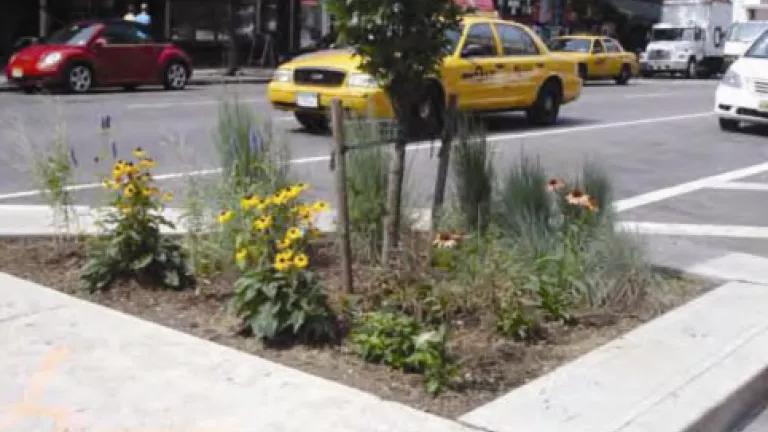
When you hear the term “high performance,” you might think of a fast sports car – or your child’s report card. But last week, New York City officials gave it a different meaning, releasing a blueprint for sustainable design for city parks and other open spaces called “High Performance Landscape Guidelines.”
This approach would change the way city parks and other public spaces are designed, built, and maintained, to maximize their contributions to solving a host of critical environmental problems the city faces. Parks would be built with sustainable designs that serve community needs well beyond providing beautiful, restful, and recreational spaces – they’ll also be used to reduce water pollution, curb climate change, improve air quality, and create habitat for birds and wildlife.
Parks goers and environmentalists aren’t the only ones excited about the future of the city’s green spaces – the line to get in to the city’s unveiling event at the Center for Architecture last week included many design mavens and stretched around the block. And the manual holds the promise of cleaner, greener neighborhoods and waterways – and even green job opportunities – something all New Yorkers can get behind.
So what makes an entire park – or a tree planter on the side of the street – “high performance?” Here are a few items from the 300-page guide that caught my eye:
Using soil to absorb rainwater naturally. The guide recommends that city planners assess park sites for their ability to deal with a host of water pollution issues, like stormwater runoff and flooding, and lists best practices for ensuring any solutions are sustainable. It asks questions like these: How well does the landscape soil absorb rainwater? Are the sidewalks made of porous materials instead of impenetrable surfaces like asphalt? When it rains, does the water drain naturally? Can rainwater be captured for watering plants, rather than sent to the sewers?
Infrastructure designs that naturally control stormwater pollution, by absorbing runoff instead of diverting it straight into sewers, keep rainwater from washing chemicals, bacteria, and litter from the city’s paved areas right into our local waterways. And it also helps to reduce the billions of gallons of untreated sewage released into those waterways every year.
Every time it rains, New York City’s antiquated sewer system becomes overloaded with a combined flow of polluted runoff and raw sewage, and huge amounts are discharged – untreated – into local waterways. This is one of the biggest causes of pollution in New York City’s waterways – and in rivers, lakes, and beaches in hundreds of other cities around the country.
Expanding the size of tree pits on sidewalks. This new approach recommends giving trees more surrounding soil space – a surprisingly simple technique that has big benefits, when applied citywide. As the new manual explains, just by giving a tree’s roots a little more room to grow, and more soil to absorb rainwater that will feed their thirst, we can “improve the health and survival rates of street trees.” And these trees “not only provide the shade and beauty that are vital to our quality of life, [but also] reduce urban heat island effect, filter air, store stormwater, and sequester carbon. Ensuring the proper sizing of tree pits will save energy, reduce asthma rates, raise property values, reduce the environmental impact from transporting and planting new trees, and decrease stormwater runoff to the combined sewer system.”
Think about it: just by giving a tree more room, we can keep the plant healthy, manage stormwater runoff, improve air quality, and curb climate change.
Creating Green Jobs. By building parks and other infrastructure with sustainable and local materials, the city can help create green jobs and reduce transportation costs. Constructing and maintaining these parks will require skilled or specialized labor, and that could increase the quality and number of green jobs in NYC.
(Credit: High Performance Landscape Guidelines: 21st Century Parks for NYC)
NRDC has long-supported integrating smart design into our green spaces. We’ve also been strong advocates for smarter water practices on land (so-called “green infrastructure” methods like increased parks, green roofs, porous pavement, etc)– ones that make a real difference in keeping pollution out of our waters.
As the city advances a bold green infrastructure initiative to reduce sewer overflows, and works to update its long-term sustainability plan, we look forward to working with the city to make sure the new guidelines are translated into practice – not only in city parks, but also along roadsides, in plazas, and in other public spaces throughout the city. We’re now another step closer to making New York an even better, greener place to live.

